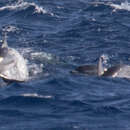en
names in breadcrumbs


The clymene dolphin was first described by Gray in 1846 from a single skull of unknown locality. He gave it the name "Delphinus metis." He then later changed the name to Delphinus clymene. The species was later placed into other genera of dolphin species. It remained doubted by cetologists until it was recently confirmed as a valid species, Stenella clymene, in 1981 by Perrin.
Little is known about the life history of the clymene dolphin.
Perception Channels: tactile ; chemical
There are no records on how many clymene dolphins have been captured or killed, but clymene dolphins are occasionally taken by harpoon in small numbers in the Lesser Antilles (Caribbean) small cetacean fishery. They are captured in gillnets in Venezuelan waters, where they are used for longline shark bait and human consumption. They may also betaken in tuna purse seines in the eastern tropical Atlantic.
Contaminant levels have not been recorded.
US Federal List: no special status
CITES: appendix ii
IUCN Red List of Threatened Species: data deficient
The only possible way that clymene dolphins can have a negative effect on humans is that they eat fish and squid. It is not clear what kind of fish and squid they eat, but if they eat the same types that humans also consume then the fish and squid could become scarce.
The clymene dolphin, when captured in gillnets, is used for shark bait and for human consumption.
The clymene dolphin feeds mostly at night when squids and small fish come to the surface of the water.
Animal Foods: fish; mollusks
Primary Diet: carnivore (Piscivore , Molluscivore )
The clymene dolphin, also known as the "short-snouted spinner dolphin," can be found in tropical and subtropical waters of the Atlantic Ocean (eastern North America to West Africa), the Caribbean, and the Gulf of Mexico. In the United States it has been recorded as far north as New Jersey and along the coast lines of Texas and Louisiana. It has also been recorded as far south as southern Brazil.
Biogeographic Regions: atlantic ocean (Native )
The clymene dolphin is a deep water species that has only been observed at sea in waters with depths of 250m-5000m or deeper. It is not normally seen near the shore.
Aquatic Biomes: coastal
The clymene dolphin is a small dolphin that averages 1.8m in length. It has a short beak, a white belly, light gray sides, and a dark cape that dips in two points above the eye and below the dorsal fin. The facial markings are very distinct, including black eye rings, dark lips and snout tip, and a dark line on top of the snouts sometimes making a "moustache" near the apex of the melon. The cape sometimes has blotchy patches on the sides, and the dorsal fin is gray but bordered with dark margins.
On average members of this species have 38 to 49 teeth on each side of the upper and lower jaws, which are slender and pointed.
Average mass: 85 kg.
Other Physical Features: endothermic ; bilateral symmetry
No information is currently available on the reproduction of the species. Some information is available for a close relative, the spinner dolphin, Stenella longiristris. Adult females of this species give birth to a single calf at 2 year intervals. Parturition most often occurs in early summer, but can occur in any season. The period of gestation is 11 months and calves are born about 75cm long.
Key Reproductive Features: gonochoric/gonochoristic/dioecious (sexes separate); sexual